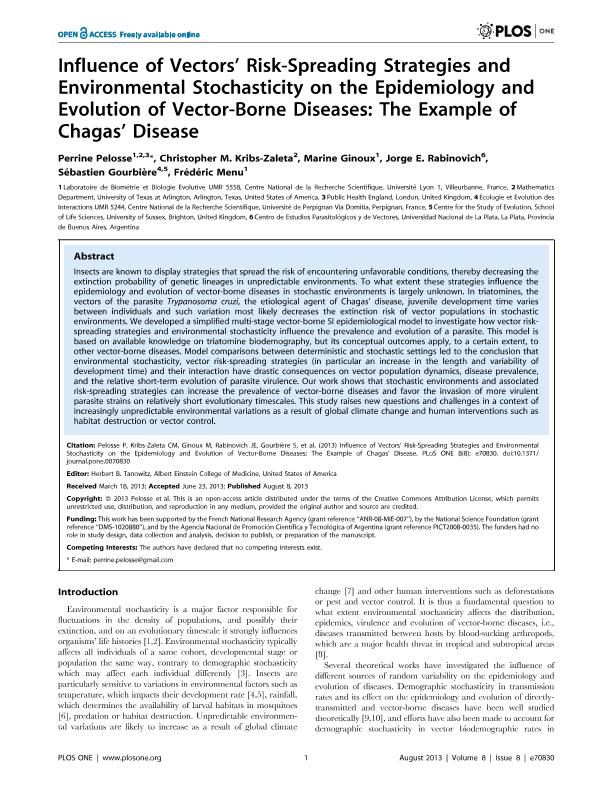Mostrar el registro sencillo del ítem
dc.contributor.author
Pelosse, Perrine
dc.contributor.author
Kribs Zaleta, Cristhoper Mitchell
dc.contributor.author
Giniux, Marine
dc.contributor.author
Rabinovich, Jorge Eduardo

dc.contributor.author
Gourbière, Sébastien
dc.contributor.author
Menu, Frédéric
dc.date.available
2019-08-06T19:32:04Z
dc.date.issued
2013-08
dc.identifier.citation
Pelosse, Perrine; Kribs Zaleta, Cristhoper Mitchell; Giniux, Marine; Rabinovich, Jorge Eduardo; Gourbière, Sébastien; et al.; Influence of Vectors' Risk-Spreading Strategies and Environmental Stochasticity on the Epidemiology and Evolution of Vector-Borne Diseases: The Example of Chagas' Disease; Public Library of Science; Plos One; 8; 8-2013; 70830-70830
dc.identifier.issn
1932-6203
dc.identifier.uri
http://hdl.handle.net/11336/81011
dc.description.abstract
Insects are known to display strategies that spread the risk of encountering unfavorable conditions, thereby decreasing the extinction probability of genetic lineages in unpredictable environments. To what extent these strategies influence the epidemiology and evolution of vector-borne diseases in stochastic environments is largely unknown. In triatomines, the vectors of the parasite Trypanosoma cruzi, the etiological agent of Chagas' disease, juvenile development time varies between individuals and such variation most likely decreases the extinction risk of vector populations in stochastic environments. We developed a simplified multi-stage vector-borne SI epidemiological model to investigate how vector risk-spreading strategies and environmental stochasticity influence the prevalence and evolution of a parasite. This model is based on available knowledge on triatomine biodemography, but its conceptual outcomes apply, to a certain extent, to other vector-borne diseases. Model comparisons between deterministic and stochastic settings led to the conclusion that environmental stochasticity, vector risk-spreading strategies (in particular an increase in the length and variability of development time) and their interaction have drastic consequences on vector population dynamics, disease prevalence, and the relative short-term evolution of parasite virulence. Our work shows that stochastic environments and associated risk-spreading strategies can increase the prevalence of vector-borne diseases and favor the invasion of more virulent parasite strains on relatively short evolutionary timescales. This study raises new questions and challenges in a context of increasingly unpredictable environmental variations as a result of global climate change and human interventions such as habitat destruction or vector control.
dc.format
application/pdf
dc.language.iso
eng
dc.publisher
Public Library of Science

dc.rights
info:eu-repo/semantics/openAccess
dc.rights.uri
https://creativecommons.org/licenses/by/2.5/ar/
dc.subject
Evolution
dc.subject
Chagas Disease
dc.subject
Trypanoisoma Cruzi
dc.subject
Mathematical Modeling
dc.subject.classification
Ecología

dc.subject.classification
Ciencias Biológicas

dc.subject.classification
CIENCIAS NATURALES Y EXACTAS

dc.title
Influence of Vectors' Risk-Spreading Strategies and Environmental Stochasticity on the Epidemiology and Evolution of Vector-Borne Diseases: The Example of Chagas' Disease
dc.type
info:eu-repo/semantics/article
dc.type
info:ar-repo/semantics/artículo
dc.type
info:eu-repo/semantics/publishedVersion
dc.date.updated
2015-05-20T18:18:10Z
dc.journal.volume
8
dc.journal.pagination
70830-70830
dc.journal.pais
Estados Unidos

dc.journal.ciudad
San Francisco
dc.description.fil
Fil: Pelosse, Perrine. Public Health England; Reino Unido. Centre National de la Recherche Scientifique; Francia. University of Texas; Estados Unidos. Université Claude Bernard Lyon 1; Francia
dc.description.fil
Fil: Kribs Zaleta, Cristhoper Mitchell. University of Texas; Estados Unidos
dc.description.fil
Fil: Giniux, Marine. Centre National de la Recherche Scientifique; Francia. Université Claude Bernard Lyon 1; Francia
dc.description.fil
Fil: Rabinovich, Jorge Eduardo. Consejo Nacional de Investigaciones Científicas y Técnicas. Centro Científico Tecnológico Conicet - La Plata. Centro de Estudios Parasitológicos y de Vectores. Universidad Nacional de La Plata. Facultad de Ciencias Naturales y Museo. Centro de Estudios Parasitológicos y de Vectores; Argentina
dc.description.fil
Fil: Gourbière, Sébastien. Centre National de la Recherche Scientifique; Francia. Université de Perpignan Via Domitia; Francia. University of Sussex; Reino Unido
dc.description.fil
Fil: Menu, Frédéric. Université Claude Bernard Lyon 1; Francia. Centre National de la Recherche Scientifique; Francia
dc.journal.title
Plos One

dc.relation.alternativeid
info:eu-repo/semantics/altIdentifier/url/http://journals.plos.org/plosone/article?id=10.1371/journal.pone.0070830
dc.relation.alternativeid
info:eu-repo/semantics/altIdentifier/doi/http://dx.doi.org/10.1371/journal.pone.0070830
Archivos asociados
